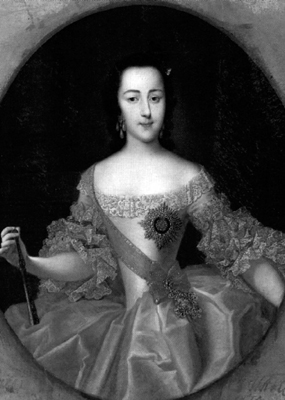Catherine the Great (40 page)
Read Catherine the Great Online
Authors: Simon Dixon
Potëmkin’s incipient rivalry with Nikita Panin was meanwhile being played out at a secondary level in the struggle between their relatives for control over the investigation into the revolt in Kazan. ‘Count Panin wants to make his brother the ruler with unlimited powers in the best part of the empire,’ Catherine complained, as Peter Panin departed for the Volga at the end of July. Though Catherine was anxious to keep the Panins’ pretensions in check, Peter’s appointment signalled a noticeable change of policy. Until then, the government had been moderate in its treatment of the rebels. In March Catherine had explicitly urged Bibikov to be cautious in his methods: ‘For twelve years the Secret Expedition under my own eyes has not flogged a single person under interrogation, and every single affair has been properly sorted out, and even more came out than we needed to know.’ Most of the prisoners taken from the rebels had been released without harm. Now retribution was placed in the hands of Peter Panin, a martinet who calculated that 324 insurgents were executed during his time in charge. A further 399 lost an ear and were knouted; 7000 more were flogged in other ways.
94
Nothing could compare in Catherine’s mind with the damage inflicted by Pugachëv himself. ‘There has hardly been anyone so destructive of the human race since Tamerlane,’ she spluttered to Voltaire in October. ‘He entertains some hope that I might treat him gracefully, saying that he might erase the memory of his past crimes by his courage and future services. If it were only me that he had offended, his reasoning would be just and I would pardon him; however, this is the empire’s cause and the empire has laws.’
95
Brought to Moscow in an iron cage on 4 November, Pugachëv was subjected to a secret trial at the Kremlin at the end of December. Vyazemsky was on hand to make sure that no torture was applied. Though the rebel was sentenced to be quartered, Catherine gave orders that his executioner should behead him first, much to the rage of the ghoulish mob that gathered to witness the event on Bolotnaya Square on 10 January.
96
Five days later, as a symbol of her determination to look forward rather than back, she decreed that the Yaik, the name of the river where Pugachëv had begun his revolt, should be changed to the Ural, ‘so that the unhappy occurrences on the said Yaik should be forgotten forever’.
97
Her wider ambition was now to consign to the same oblivion the ‘blindness, stupidity, ignorance and superstition’ that had tempted her subjects into rebellion. And that meant tackling the ‘weakness, indolence, carelessness in respect to their duties, idleness, arguments, disagreements, extortions and injustices’ perpetrated by her inadequate provincial officials.
98
The task of improving local government was to preoccupy her for much of the following decade.
With Pugachëv gone, Moscow was safe to visit, seven years after Catherine had last set foot in the old capital. ‘Seven years seems like a whole century to us,’ Sumarokov made the populace exclaim in his
Ode to Potëmkin
in 1774. But since the empress was less certain of a rapturous reception, she delayed her departure until news of the pretender’s execution had been confirmed, making her formal entry into Moscow on 23 January 1775.
99
Passing two newly erected triumphal arches, commemorating her victories against the Turks, she processed to the customary service at the Dormition Cathedral, and from there to her new palace, where she retired to her apartments. ‘The whole passed with scarce any acclamations amongst the populace, or their manifesting the least degree of satisfaction,’ Gunning reported secretly to Whitehall. ‘The Empress’s visit here is far from agreeable to them, and as little so to the nobility. Her Majesty is not ignorant of
this, nor of the little affection they bear her; nor are they less acquainted with the unfavourable opinion she entertains of them.’
100
Inside the porticoed entrance of the Prechistensky Palace, Matvey Kazakov had created a large reception room leading to a throne room, just as big, where Catherine could receive the ambassadors. Beyond that lay a still greater apartment, running the length of the building and divided by columns: she played cards in one half while her courtiers danced in the other.
101
‘To be fair,’ as she acknowledged to Grimm, the conversion had been artfully done. But she enjoyed poking fun at the ‘labyrinth’ connecting the disparate parts of her new palace, portraying her new study as ‘a triumph of exits’ from which it had taken her two hours to escape. ‘I have never seen so many doors in my life. I have already condemned half a dozen of them, and I still have twice as many as I need.’
102
Thrust into this unfamiliar environment, Catherine and Potëmkin struggled to maintain the explosive intensity of their initial affair, relapsing instead into bickering about the terms of their relationship. It was already clear that they were partners in government. Indeed, when her sulky lover took offence at some corrections she sent him, she assured him that they were ‘only guidelines’ from which he could make his own choice. While he set to work to ensure that there could never be another Pugachëv, she concentrated on commemorating the defeat of the Turks. At first sight, it was Potëmkin who had the more ambitious task and he set about it with characteristic ruthlessness. Powerless to intervene, Panin watched in horror as the new favourite heaped obloquy on the errant Zaporozhian Cossacks barely twelve years after they had taken a proud role at the empress’s coronation. Their host was summarily disbanded on 3 August and its territory assimilated under the regular imperial administration.
103
Meanwhile, Catherine had taken responsibility for an equally visionary piece of legislation. The manifesto commemorating the end of the Turkish war on 17 March 1775 has rightly been accorded ‘considerable importance in the history of human rights in Russia’ because it offered unprecedented protection to the individual by preventing the arbitrary enserfment of the population by census-takers who had deprived more than 830,000 men of their freedom between 1721 and 1741 alone.
104
The vagaries of life with Potëmkin help to explain why Easter Sunday found Catherine in wistful mood about Grigory Orlov. ‘If ever you catch sight of him,’ she wrote to Frau Bielke, ‘you will see without contradiction the finest man that you have ever encountered in your life.’
105
Paul and his wife were treated less charitably. Now that Natalia’s wilfulness had begun to emerge, the empress’s patience was starting to wear thin. She mocked the girl’s headstrong profligacy in
a letter to Grimm in December: ‘we cannot stand this or that; we are indebted beyond twice what we have, and what we have is twice more than anyone else in Europe.’
106
Now that her son had requested a further 20,000 roubles, she grumbled to Potëmkin that there would be ‘no end to it’: ‘If you count everything, including what I have given to them, then more than five hundred thousand has been spent on them this year, and still they want more. But neither thanks nor a penny-worth of gratitude!’
107
On the whole, however, Catherine’s mood was positive. Even the obligatory summer pilgrimage to the Trinity monastery, with the Chernyshëvs and Kirill Razumovsky in tow, turned out to be ‘very agreeable and a real promenade: we had fine weather and good company and weren’t bored for a moment; I returned in perfect health’.
108
Unfortunately, it was not to last. The peace celebrations had to be postponed when a surfeit of peaches gave her chronic diarrhoea. Onlookers remembered her looking old when she was finally fit to attend having been bled by the medics. On the southern perimeter of the city, fourteen obelisks, each decorated with battle scenes, had been erected to commemorate the greatest victories of the war. From there, the troops marched through the two similarly adorned triumphal arches toward the Kremlin, where Catherine processed down the Red Staircase just as she had at her coronation, only this time in full military uniform. The sound of Slizov’s bell ‘was so tremendous that it seemed that the Ivan Tower itself trembled’, recalled Andrey Bolotov at the beginning of the nineteenth century. ‘Many of us feared it would collapse.’ Bazhenov had initially proposed temples to Janus, Bacchus and Minerva, but Catherine was having none of it. Classical imagery was deliberately excluded as the empress insisted on a range of neo-Gothic structures, erected on Khodynka field at the north-western edge of the city. All of them found their place on an imaginary map of the Black Sea, where Kerch and Yenikale were made to serve as ballrooms, Kinburn as a theatre, and Azov a huge banqueting hall.
109
Not since the carousel of 1766 had the Court been treated to such a riot of medievalism. The Black Sea transported to a field near Moscow? It was too much even for Voltaire: ‘I knew very well that the very great Catherine II was the leading person in the whole world; but I hadn’t realised that she was a magician.’
110
In the midst of this glorious fantasy, the empress had turned her very practical mind to one of the most significant statutes of her reign, the Provincial Reform of November 1775, designed to bring her government closer to the people through a rationalisation of local administration in the wake of the Pugachëv rebellion. Though six surviving drafts in her own hand testify to the depth of
Catherine’s commitment to the legislation, the ideas in it came from her advisers. The most influential was Yakov Sievers, who had been brought to Moscow to help her with the reform. ‘Work this out with Sievers,’ ran a typical note on one of her drafts. ‘This is the most stupid article of all,’ she confessed at a moment of particular frustration. ‘My head hurts from it. This endless rumination is very dry and boring. To tell the truth, I am already at the end of my Latin, and I do not know what to do about the Lower Court, the Board of Public Welfare, and the Conscience Court. One word from your excellency on these subjects would be a ray of light, bringing order out of chaos, as when the world was created.’
111
In November, Sievers was appointed Governor General of Tver, Novgorod, Olonets and Pskov, an area larger than many European states in which he was given the honour of being the first to put the new reform into practice. As a sign that they had been appointed as the empress’s personal viceroys, he and Zakhar Chernyshëv in Belorussia were each rewarded with an English silver service weighing over 45 poods. Catherine eventually paid a total of 125,000 roubles for the two services, setting aside a further 42 roubles and 35 kopecks to provide fur coats for officers in the troop which accompanied the final consignment.
112
‘I think these regulations are better than my Instruction for the code,’ she told Grimm in January 1776. ‘They are being introduced at this moment in the provinces of Tver and Smolensk where they have been received with open arms.’
113
The Court had returned to St Petersburg in December. It would be another ten years before Catherine saw Moscow again. By then, the city and the surrounding provinces had been transformed almost beyond recognition, at least in part by her own reforming zeal. Yet even that transformation paled by comparison with the turbulence in the empress’s personal life.
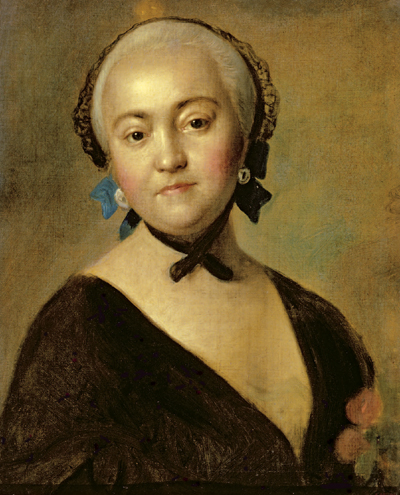
Peter III’s tutor, Jacob Stählin, thought Rotari’s portrait of Elizabeth in a black lace mantilla the best likeness of this beautiful, irascible empress. Done in the last years of her life, it passed into the collection of her young favourite, Ivan Shuvalov.
Empress Elizabeth Petrovna (1709–61) by Pietro Antonio Rotari (1707–62): State Russian Museum, St. Petersburg, Russia/The Bridgeman Art Library
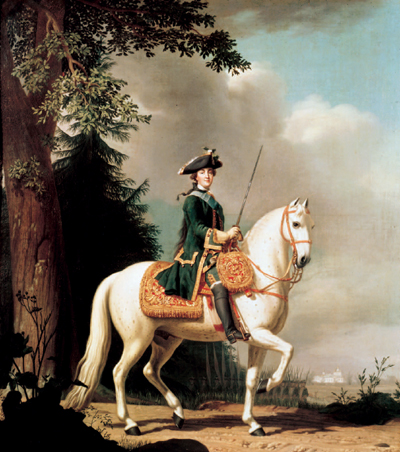
The prevailing myth of a conquering foreign ruler bringing civilization and prosperity to Russia is encapsulated by Vigilius Erichsen’s portrait of the uniformed empress astride Brilliant, the charger she rode out towards Oranienbaum the day after her coup.
Equestrian Portrait of Catherine II (1729–96) the Great of Russia by Vigilius Erichsen (1722–82): Musée des Beaux-Arts, Chartres, France/The Bridgeman Art Library
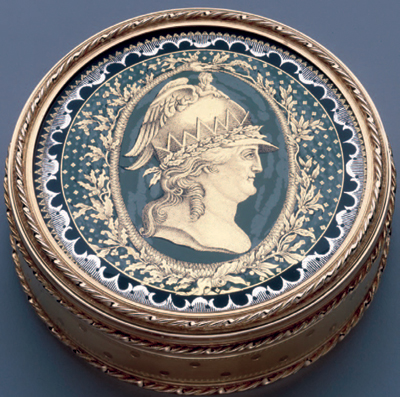
To ensure that enlightened female rule was not mistaken for weakness, Catherine’s image-makers represented her as Minerva, the war-like goddess of Wisdom, from the time of her coronation in 1762. This Parisian snuff-box may well have been made to mark her son’s visit to the French capital, twenty years later.
Round snuff-box showing Catherine as Minerva, Paris 1781–2 (gold, verre églomisé, silver): Hillwood Estate, Museum & Gardens; Bequest of Marjorie Merriweather Post, 1973, photo by Ed Owen
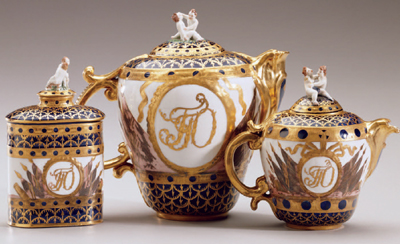
‘If ever you catch sight of him, you will see without contradiction the finest man that you have ever encountered in your life.’ Embracing putti symbolise Catherine’s love for Grigory Orlov on the service she commissioned for him from the Imperial Porcelain Factory sometime between 1762 and 1765.
Tea caddy, coffeepot, and teapot from the Orlov Service, St. Petersburg, Imperial Porcelain Factory, 1762–5: Hillwood Estate, Museum & Gardens; Bequest of Marjorie Merriweather Post, 1973, photo by Ed Owen
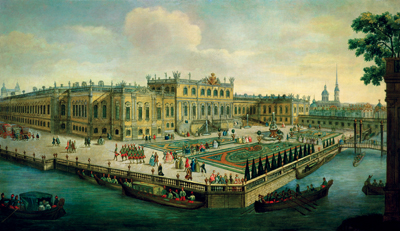
Completed as she arrived in Russia, Rastrelli’s Summer Palace on the Fontanka was an exuberant timber fantasy that survived Catherine’s reign, along with many other features of a Baroque Court, before being demolished by order of Paul I.
The Summer Palace, St. Petersburg, Russian School (18th century): State Russian Museum, St. Petersburg, Russia/Giraudon/The Bridgeman Art Library

Exemplified by the Green Dining Room, Charles Cameron’s cool interiors at Tsarskoye Selo marked the triumph of the restrained neoclassical style in Russian architecture from the late 1770s.
Summer Palace, Tsarskoye Selo, Green Dining Room, designed by Charles Cameron, 1784–91: Bridgeman Art Library, London
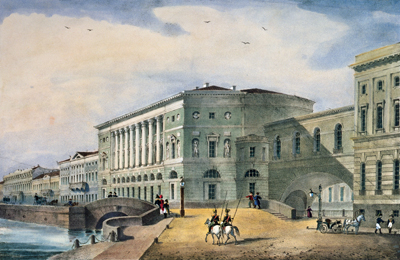
The empress’s comedies and operatic pageants played to select audiences at Giacomo Quarenghi’s neoclassical Hermitage Theatre, which opened on 22 November 1785. Catherine entered from the adjoining Hermitage, guests from the granite-clad embankment, itself admired as a ‘grand work, which, in regard to utility and magnificence’ could not ‘be paralleled except among the ruins of ancient Rome’.
The Hermitage Theatre seen from Vasilevsky Island, 1822 (colour lithograph), Russian School (19th century): Pushkin Museum, Moscow, Russia/The Bridgeman Art Library
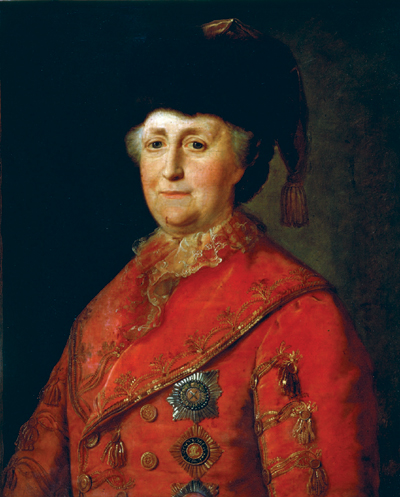
Done in Kiev in 1787, Mikhail Shibanov’s portrait of the empress in travelling dress combines the image of a maternal ruler with the expansionist ambitions represented by the insignia of three chivalric orders: St Andrew the First Called (founded by Peter I), St George (founded ‘for bravery’ during the Russo-Turkish war of 1768–74) and St Vladimir (founded in 1782, the year in which the empress outlined her ‘Greek Project’ in a letter to Joseph II of Austria).
Catherine II in a travelling costume, 1787 by Mikhail Shibanov (f1.1783–89): State Russian Museum, St. Petersburg, Russia/The Bridgeman Art Library

‘His rarest quality was a courage of heart, mind and soul which set him completely apart from the rest of humanity.’ Potëmkin’s outsized personality is well captured in Giovanni Battista Lampi’s celebration of his martial valour, painted in the last year of the prince’s life.
Prince Grigory Aleksandrovich Potëmkin (1739–91), c.1790 by Johann Baptist I Lampi (1751–1830): Hermitage, St. Petersburg, Russia/The Bridgeman Art Library
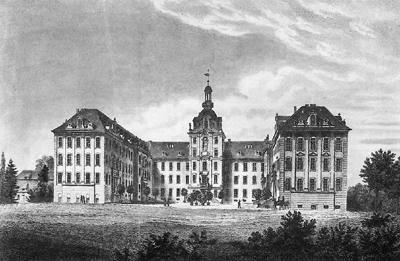
Small as it was, the palace at Zerbst provided Catherine’s father, Prince Christian August, with the quintessentially cosmopolitan setting of a Baroque Court in miniature.
The Schloss at Zerbst
